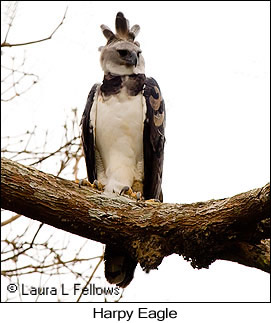PANAMA BIRDING TRIP REPORT

TRIP REPORT
PANAMA
| Start: | 02/25/2006 |
| End: | 03/11/2006 |
| Duration: | 15 days |
| #Species: | 373 |
| #Endemics: | 33 |
| #Heard Only: | 8 |
2006 Panama Highlights Birding Tour
TOUR DESCRIPTION
While in the Canal Zone, we stayed at the Plaza Paitilla Inn located on Bahia Bay in central Panama City. The hotel was recently renovated and is very comfortable. The hotel is very affordable compared to available ecolodges, so by staying in the city we were able to keep the trip cost substantially lower than it would have been otherwise. The main drawback of staying in the city is that the best birding areas are 30-60 minutes away, which made for some early departures every morning. However, by sacrificing a little sleep we experienced some fantastic birding.
We spent our first morning birding along world-famous Pipeline Road, one of the best birding areas in Central America. The road is closed to traffic and the first 6 km. offer great birding. While birding the road, we were lucky enough to encounter a Harpy Eagle perched right overhead on a branch. Several Harpies have been released into the area, but they are rarely seen by birders along the road. Other notable birds we saw along the road included Band-rumped Short-tailed, and Lesser Swallow-tailed Swifts, Black-throated Mango, Sapphire-throated Hummingbird, three species of trogons, Black-breasted Puffbird, White-flanked Antwren, Dusky Antbird, Chestnut-backed Antbird, Bicolored Antbird, Golden-collared Manakin, Blue-crowned Manakin, Yellow-olive Flycatcher, Ruddy-tailed Flycatcher, Rusty-margined Flycatcher, Long-billed Gnatwren, a good variey of tanagers, and Scarlet-rumped Cacique. Along the approach road toward Pipeline Road we picked up some open habit birds such as Fork-tailed Flycatcher, Yellow-bellied Seedeater, and Ruddy-breasted Seedeater.
That same afternoon we visited the Ammo Dump ponds, where we found some aquatic birds including Striated Heron, Rufescent Tiger-Heron, Gray-necked Woodrail, Wattled Jacana, and two Southern Lapwings, a species that has been expanding its range northward in recent years.
We spent our second day birding along the Old Gamboa Road, which is now also closed to traffic. We saw many of the same species we saw the day before along Pipeline Road but added Short-tailed Hawk, Blue-headed Parrot, Long-billed Hermit (formerly named Western Long-tailed Hermit, Violet-crowned Woodnymph, Violet-bellied Hummingbird, Charming Hummingbird, Snowy-bellied Hummingbird, Purple-crowned Fairy, Broad-billed Motmot, White-whiskered Puffbird, Crimson-crested Woodpecker, Spotted Antbird, Silvery-throated Tapaculo, a secretive bird only seen by a couple participants as it flew across the road, Forest Elaenia, Ochre-bellied Flycatcher, Black-capped Pygmy-Tyrant, Olivaceous Flatbill, Golden-crowned Spadebill, Black-bellied Wren, Black-chested Jay, Fulvous-vented Euphonia, Blue Dacnis, Green Honeycreeper, Shining Honeycreeper, and Slate-colored Grosbeak.
On our third day we visited Cerro Azul and Cerro Jefe. February is not the best time of year for these locales because it's typically windy and rainy, and our visit was no exception. The group didn't want to walk the 6 km up the gravel road to the radio towers on Cerro Jefe where endemics such as Tacarcuna Bush-Tanager are found, so we missed those. We stayed at lower elevations and did see Black Hawk-Eagle, Snowy-bellied Hummingbird again, Olivaceous Woodcreeper, Tropical Pewee, and Rufous-capped Warbler. We then headed to lower elevations around the western side of the bay and found a variety of herons, egrets, raptors, and shorebirds.
On the fourth day of our tour, we got an early start and drove to the Caribbean side of the Canal Zone. Our destination was acclaimed Achiote Road, and the birding did not disappoint. Notable birds we saw there included White Hawk, Mangrove Black-Hawk, , a rare look at a Limpkin flying overhead before disappearing into deep grass of a wetland, Gray-rumped Swift, Bronzy Hermit, Blue-chested Hummingbird, Black-headed Trogon,, great looks at a Pied Puffbird perched cooperatively in the open, Panama Flycatcher, White-ringed Flycatcher, White-winged Becard, Black-crowned Tityra, White-lined Tanager, Flame-rumped Tanager, White-vented Euphonia, Streaked Saltator, Blue-black Grosbeak, and Red-breasted Blackbird. We unfortunately missed the Blue Cotinga that was seen by another group who had arrived shortly after we did. Sometimes timing is everything! Our plan for the afternoon was to visit the old Spanish Fortress of San Lorenzo. However, the best laid plans sometimes go awry, and ours did when we stopped on the road back from toward Gatun to view an American Kestrel. While we were stopped, a Panamanian driver slammed into the rear of our tour bus, leaving us stranded while the police filled out accident reports for the next couple hours. In defense of our guide, it WAS the only Kestrel we saw on the tour.
The following morning we were up early to go birding along the road up Semaphore Hill and on Plantation Trail in Soberania National Park. These are also prime birding areas. Aside from species we had already seen along Pipeline Road and Old Gamboa Road, we found Least Grebe, Boat-billed Heron, Gray-headed Kite, Peregrine Falcon, great looks at a pair of lovely Spectacled Owls, Garden Emerald, Amazon Kingfisher and American Pygmy Kingfisher, Jet Antbird, Black-faced Antthrush, Lesser Kiskadee, Rosy Thrush-tanager (seen by a few participants only), and Yellow-billed Cacique.
Next morning early we went birding in Metroplitan Park, a large park with expansive dry lowland forest inside the city limits of Panama City. Notable birds we saw there included White-necked Puffbird and Orange-billed Sparrow, along with a variety of species we also saw elsewhere. That afternoon we flew to David in Chiriqui Province, where we spent the next three days of the tour.
We spent a full day birding along the famed Fortuna Road that goes between the Pacific and Caribbean sides of the province. We left early and encountered heavy fog until we reached the vicinity of Willie Mazu's camp. We birded along the road for a while and then birded a trail near the Continental Divide at higher elevation. Birds we saw there and nowhere else included Common Black-hawk, White-crowned Parrot, White-collared Swift, Violet-headed Hummingbird, Green Thorntail, White-ruffed Manakin, Olive-streaked Flycatcher, Scale-crested Pygmy-Tyrant, Band-backed Wren, Olive-crowned Yellowthroat, Yellow-throated Bush-Tanager, Dusky-faced Tanager, Tawny-crested Tanager, Olive-backed Euphonia, Emerald Tanager, Bay-headed Tanager, and Black-faced Grosbeak.
We spent the better part of two days exploring higher elevation areas around Volcan Baru, particularly La Amistad Heritage Park and areas around Cerro Punta and Guadalupe. We had a postcard-perfect view of a male Resplendent Quetzal in full breeding regalia while in La Amistad. Other notable birds we saw included Maroon-chested Ground-Dove, Sulphur-winged Parakeet, Violet Sabrewing, Fiery-throated Hummingbird, Stripe-tailed Hummingbird, Scintillant Hummingbird, Volcano Hummingbird, Collared Trogon, Lineated Foliage-gleaner, Spotted-crowned Woodcreeper, Blue-and-white Swallow, Black-and-yellow Silky-Flycatcher, Long-tailed Silky-Flycatcher, Black-faced Solitaire, Slaty-backed Nightingale-Thrush, Black-billed Nightingale-Thrush, Ruddy-capped Nightingale-Thrush, Mountain Robin, Flame-throated Warbler, Collared Redstart, Black-cheeked Warbler, Sooty-capped Bush-Tanager, Flame-colored Tanager, Cherrie's Tanager, Silver-throated Tanager, Speckled Tanager, Scarlet-thighed Dacnis, Yellow-thighed Finch, Large-footed Finch, Yellow-throated Brush-finch, Chestnut-capped Brush-finch, Rufous-collared Sparrow, and Yellow-tailed Oriole.
All but two persons on the tour continued with our extension to the Mogue River area of Darien Province in the Punta Patino. This part of the tour was organized by Ancon Expeditions and was guided by them rather than Adolfo Downs. We were the very first birding tour group to ever visit the Embara Indian Village of Llano Bonito (the artist David Kitler and his wife visited the area earlier in December 2005). It was a somewhat strenous 6-hour hike to the village that would have been harder and longer if the trail had been muddy. En route we saw two Crested Eagles soaring overhead, along with a number of forest birds including Black-tailed Trogon, a Darien specialty. However, birding was limited as we had to reach the village by nightfall. Upon our arrival at Llano Bonito, we received the royal welcome by the designated headman and most of the women and children in the village. The villagers were extremely curious about us and extremely welcoming. They performed several traditional dances for us, we gave them gifts we had carried in, and then we enjoyed visiting with the villagers and showing curious kids the photos we were taking of them, which was all very new for them.
The following morning we hiked up to the active Harpy Eagle nest, our primary purpose for visiting Llano Bonito, and had great looks at a recently fledged juvenile. The adults were nowhere to be seen. We also saw several Darien specialties, including Orange-crowned Oriole and Black Oropendola.
That afternoon we hiked from Llano Bonito to another Embara village, La India, where we tent-camped for the night. The following day we hiked to an area near the village of Mogue, site of an older Harpy Eagle nest that had been recently removed by the Panama Audubon Society and relocated to another site to encourage further nesting activity. We saw another Crested Eagle soaring overhead during our hike to La India, and we had terrific looks at a nesting Ornate Hawk-Eagle near our tent camp outside Mogue, but we didn't see any more Harpy Eagles. Notable birds we saw during our trek into the Darien, in addition to those already mentioned, included Capped Heron, Plumbeous Hawk, White-tailed Hawk, the usually quite secretive Striped Cuckoo that we saw very well, Band-rumped Swift, Band-tailed Barbthroat, White-necked Puffbird, Pied Puffbird, a great look at the elusive Gray-cheeked Nunlet, Russet Antshrike, Orange-collared Manakin, Golden-headed Manakin, Sirystes, Rufous Mourner, Cinnamon Becard, Fulvous-vented Euphonia, Thick-billed Seed-Finch, Yellow-backed Oriole, and Crested Oropendola.
BIRDING LOCALES






